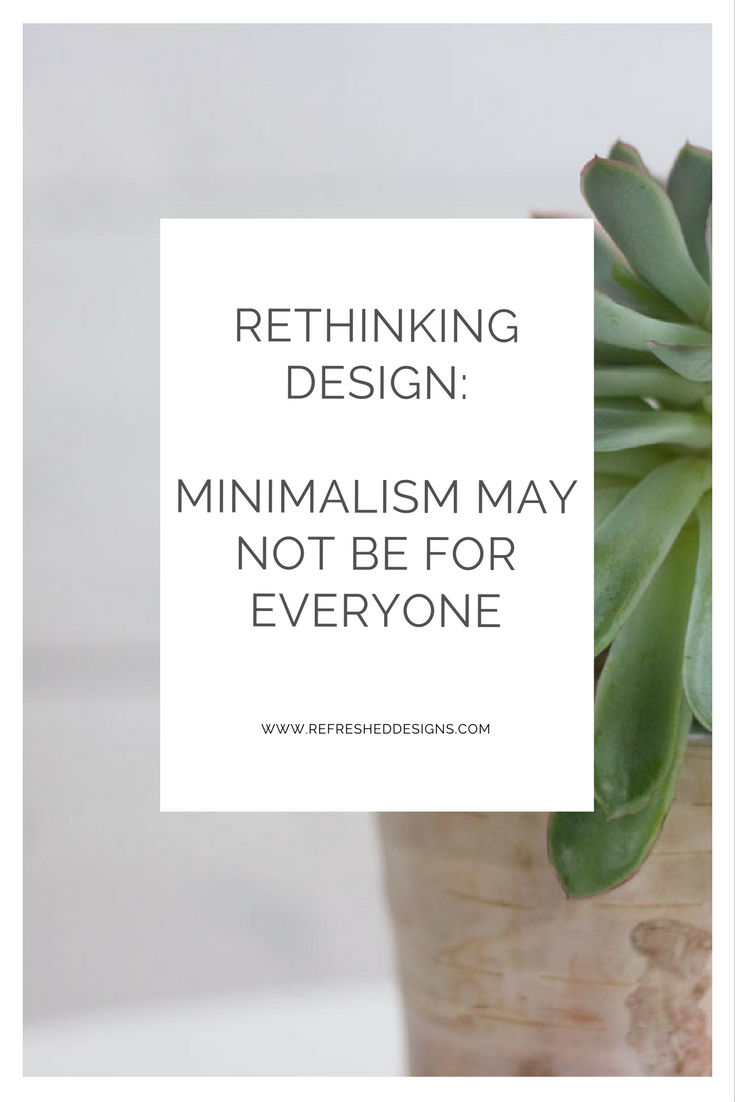I’m a big believer in simplifying and have been since I was a kid and ditched every Encyclopedia Britannica volume in my room except A and Z. I always try to simplify my kitchen cupboards, a work project or a heated conversation with someone. Taking a high-level view of a situation to see it from the most basic perspective can clarify what’s really needed for the best outcome.
Minimalism? Yep, no question I’m a big believer in that too, especially when implemented to create freedom, as espouse. I’m completely on board with freeing ourselves of physical and emotional clutter so that we can experience more in life instead of own more. I’ve seen the powerful effect minimalism has had in my own life and in clients’.
But it’s not always that simple.
Taking a blanket approach that minimalism is the ticket to freedom for everyone is not taking a high-level view, in my opinion. People are different, are in different stages of life, and respond differently to their environments. I’ve witnessed efforts to achieve minimalism that caused anxiety and depression. It can be distressing to give things up that you’ve worked hard for, that give you comfort, or that have been a part of your life for a long time. Guilt can creep in if our homes don’t live up to the calming and perfect minimalist spaces that taunt us on Pinterest and Instagram.
Less clutter in our lives is certainly a good thing, but there needs to be more to it than just reducing. After all, we want to increase our lives – as in increased joy, relationships, health, giving, experiences and contribution.
I suggest that a better word/philosophy/style to aspire to might be Essentialism.
book really hit home with me last year when I read it for the first time (and a couple more since then) and I’ve implemented it in my personal life, at work with my team and in my own small business. McKeown boils it down to this:
“Essentialism is not about how to get more things done; it’s about how to get the right things done. It’s about making the wisest possible investment of your time and energy.”
Essentialism gets to what minimalism is, I believe, trying to achieve, but sometimes misses the mark on with individuals who don’t delve into it for the right reasons.
Essentialism is about optimizing what we keep in our lives in the pursuit of doing better. It focuses in on what we need for an abundant life that is meaningful, healthy and true to only ourselves. This of course is different for all – some need more, some need less.
At the heart of being able to pursue less but better is discerning between your internal voice and all of the external noise.
That’s where simplifying and minimalizing can be useful. If we reduce the external noise – paper clutter, useless emails, boxes of junk sitting in the garage, unproductive meetings, too many choices of clothing, to name a few – we can better hear our internal voice. We need space for quiet reflection, time for play and movement, the ability to get enough sleep, and discipline to make tough choices.
Once we can hear our internal voice (and it takes practice) and determine what is essential to our own best life, we can intentionally spend our time, money, space, thoughts and feelings on only those things.
“The way of the Essentialist means living by design, not by default.”
I’ve committed to living not as a minimalist, but as an Essentialist. I’m designing my spaces, my work and my time to live in this way. A few examples include:
- Blocking all of my essentials into my calendar first, so that exercise, meditation, writing, and time with friends and family do not get crowded out by day-day things.
- Carving out my own space at home for quiet reflection, listening, and strategizing.
- Making my bedroom an oasis that encourages sleep.
- Painting my walls soothing light colours that make me feel serene and calm.
- Reducing all clutter in my office and home that doesn’t bring me joy, functionality or productivity.
- Putting to use and on display the meaningful things in my life, like the desk my dad hand-made for me, photography of places I used to live, and mementos that make me smile and take a breath.
- Making daily necessities easier and more efficient, thereby saving me time and mental energy.
Minimalism is wonderful for many; I’m not dismissing it. Not by a long shot. I love how rocks it so she can “”
I’m simply advocating that every individual who craves something more, less, or different take a high-level view of their life to get to the root of what they really want from it. Then consider the way of the Essentialist. And maybe keep volumes B-Y.































